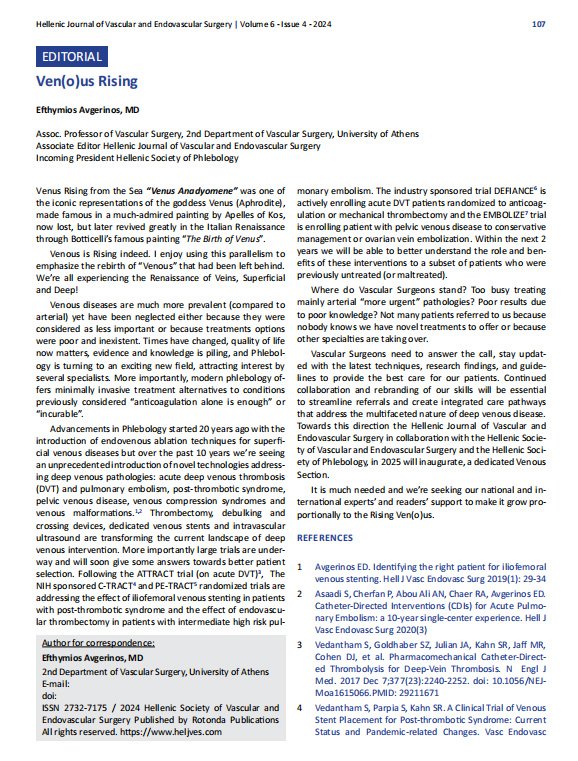Ven(o)us Rising

| Available Online: | May, 2024 |
| Page: | 107-108 |
Author for correspondence:
Efthymios Avgerinos, MD
2nd Department of Vascular Surgery, University of Athens
E-mail: [email not shown in original]
ISSN 2732-7175 / 2024 Hellenic Society of Vascular and Endovascular Surgery Published by Rotonda Publications
All rights reserved. https://www.heljves.com
Full Text
References
Full Text
Venus Rising from the Sea “Venus Anadyomene” was one of the iconic representations of the goddess Venus (Aphrodite), made famous in a much-admired painting by Apelles of Kos, now lost, but later revived greatly in the Italian Renaissance through Botticelli’s famous painting “The Birth of Venus”. Venous is Rising indeed. I enjoy using this parallelism to emphasize the rebirth of “Venous” that had been left behind. We’re all experiencing the Renaissance of Veins, Superficial and Deep!
Venous diseases are much more prevalent (compared to arterial) yet have been neglected either because they were considered as less important or because treatments options were poor and inexistent. Times have changed, quality of life now matters, evidence and knowledge is piling, and Phlebology is turning to an exciting new field, attracting interest by several specialists. More importantly, modern phlebology offers minimally invasive treatment alternatives to conditions previously considered “anticoagulation alone is enough” or “incurable”.
Advancements in Phlebology started 20 years ago with the introduction of endovenous ablation techniques for superficial venous diseases but over the past 10 years we’re seeing an unprecedented introduction of novel technologies addressing deep venous pathologies: acute deep venous thrombosis (DVT) and pulmonary embolism, post-thrombotic syndrome, pelvic venous disease, venous compression syndromes and venous malformations.1,2 Thrombectomy, debulking and crossing devices, dedicated venous stents and intravascular ultrasound are transforming the current landscape of deep venous intervention. More importantly large trials are underway and will soon give some answers towards better patient selection. Following the ATTRACT trial (on acute DVT)3, The NIH sponsored C-TRACT4 and PE-TRACT5 randomized trials are addressing the effect of iliofemoral venous stenting in patients with post-thrombotic syndrome and the effect of endovascular thrombectomy in patients with intermediate high risk pulmonary embolism. The industry sponsored trial DEFIANCE6 is actively enrolling acute DVT patients randomized to anticoagulation or mechanical thrombectomy and the EMBOLIZE7 trial is enrolling patient with pelvic venous disease to conservative management or ovarian vein embolization. Within the next 2 years we will be able to better understand the role and benefits of these interventions to a subset of patients who were previously untreated (or maltreated).
Where do Vascular Surgeons stand? Too busy treating mainly arterial “more urgent” pathologies? Poor results due to poor knowledge? Not many patients referred to us because nobody knows we have novel treatments to offer or because other specialties are taking over.
Vascular Surgeons need to answer the call, stay updated with the latest techniques, research findings, and guidelines to provide the best care for our patients. Continued collaboration and rebranding of our skills will be essential to streamline referrals and create integrated care pathways that address the multifaceted nature of deep venous disease.
Towards this direction the Hellenic Journal of Vascular and Endovascular Surgery in collaboration with the Hellenic Society of Vascular and Endovascular Surgery and the Hellenic Society of Phlebology, in 2025 will inaugurate, a dedicated Venous Section.
It is much needed and we’re seeking our national and international experts’ and readers’ support to make it grow proportionally to the Rising Ven(o)us.


